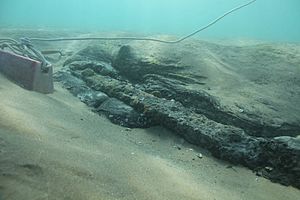Battle of Barcelona facts for kids
Quick facts for kids Battle of Barcelona |
|||||||
|---|---|---|---|---|---|---|---|
| Part of the Franco-Spanish War (1635–59) | |||||||
 Probable remains of the French De Marsay outbreak , located in 2015 near the coast of Sitges |
|||||||
|
|||||||
| Belligerents | |||||||
| Commanders and leaders | |||||||
| Strength | |||||||
| 44 sailing vessels, 17 galleys, 14 fireships |
36 sailing vessels, 10 galleys, 6 fireships, 35 barcos longos |
||||||
| Casualties and losses | |||||||
| 1 galleon and 1 fireship | 2 galleons and 4 fireships | ||||||
The Naval Battle of Barcelona was a big sea fight. It happened near Barcelona, Catalonia, Spain, from June 29 to July 3, 1642. This battle was part of the Franco-Spanish War. The battle was between the Spanish fleet, led by Juan Alonso Idiáquez, and the French fleet, led by Jean Armand de Maillé-Brézé.
Over three days, the French fleet, led by Maillé-Brézé, won the battle. The Spanish fleet was trying to help Spanish troops stuck along the Catalan coast. After the defeat, the Duke of Ciudad Real had to take his ships to Majorca for repairs. The French fleet used many fireships (ships filled with flammable materials to set enemy ships on fire). However, a large French ship, the Galion de Guise, accidentally caught fire from one of its own fireships and sank. Even so, the French won. This victory helped the Franco-Catalan army capture Perpignan later that year.
Contents
Why the Battle Happened
The Reapers' War, or the Catalan Uprising, started in 1640. This was a rebellion against the Spanish Monarchy. By mid-1641, most of Catalonia was controlled by the rebels and their French allies. Spanish forces were only in areas like Tarragona, Tortosa, and some isolated ports.
The French leader in Catalonia, Philippe de La Mothe-Houdancourt, tried to take Tarragona. But a French fleet blocking the port was not strong enough. It could not stop a large Spanish supply convoy from reaching Tarragona. The French commander, Henri d'Escoubleau de Sourdis, thought it was better to capture Collioure. This would cut off supplies to the Spanish army in Perpignan. Cardinal Richelieu replaced him with his nephew, Jean Armand de Maillé-Brézé. For the 1642 campaign, the French decided to focus on taking Roussillon.
French Fleet Gets Ready
Marshall Charles de La Porte captured Collioure on April 13. Then, with Frederick Schomberg, he began to surround Perpignan. The French plan was for their fleet to block the coast between Tarragona and Collioure. They were ready to fight the Spanish fleet if needed.
French ships from different areas gathered near Barcelona. The Brest squadron, with 21 sailing ships, 2 supply ships, and 6 fireships, arrived on June 10. The Toulon squadron, with 19 sailing ships, 4 supply ships, and 6 fireships, arrived on May 8. A fleet of 25 galleys arrived on June 21. The French fleet also included a small group of ships already near Catalonia. Plus, ten English and Dutch ships were hired. This made the French fleet almost 60 ships strong. On June 22, Maillé-Brézé sailed his ships to find the Spanish fleet.
Spanish Fleet Prepares
Spanish naval leaders tried to get their fleet ready quickly. They wanted to stop the French fleets from joining up, but they failed. So, they focused on gathering as many ships as possible. This relief fleet was meant to help Spanish troops stuck along the coast, especially in Roussillon.
Helping by sea was the only option. A Spanish army trying to reach Perpignan by land had been defeated. This happened at the Battle of Montmeló and the Battle of La Granada. In these battles, about 3,500 Spanish soldiers were captured. Because of this defeat, all of Castile was put on war alert. Foreign and private ships were taken for the war. Silver from people was melted down to make coins to pay soldiers. Soon, Cádiz was full of soldiers and sailors.
The Duke of Ciudad Real was put in charge of the Spanish fleet. He did not have much experience in sea battles. Admiral General Sancho de Urdanivia was his second-in-command. The Spanish fleet had 31 large sailing ships, 2 frigates, 3 smaller patrol ships, 6 fireships, and a convoy of supply boats. They also had 35 barcos longos, which were new types of ships designed to fight fireships.
The Battle Begins
The Spanish fleet arrived near Barcelona on June 29, around 3:00 PM. Even though it was late and the sea was rough, they attacked the French right away. The battle lasted until sunset. The Spanish tried to board some French ships, but they were not successful. The French launched one fireship, and the Spanish launched three, but none of them caused much damage.
The next day, the slower Spanish galleys reached Barcelona. The full Spanish fleet attacked again. This time, the Spanish ship Magdalena and some smaller ships managed to surround the large French ship Galion de Guise. They threatened to board it. The French launched a fireship at the Magdalena. However, the Spanish crew managed to push the fireship away. It drifted towards the Galion de Guise instead. The Galion de Guise caught fire and exploded. Its commander, Vice Admiral Hercule de Conigan de Cangé, 500 French sailors, and 30 Spanish prisoners on board all died.
On July 3, the battle continued. This time, the French cannons were more powerful. Several Spanish ships were badly damaged. The Duke of Ciudad Real had to retreat. The French won the battle.
See also
 In Spanish: Batalla de Barcelona (1642) para niños
In Spanish: Batalla de Barcelona (1642) para niños

